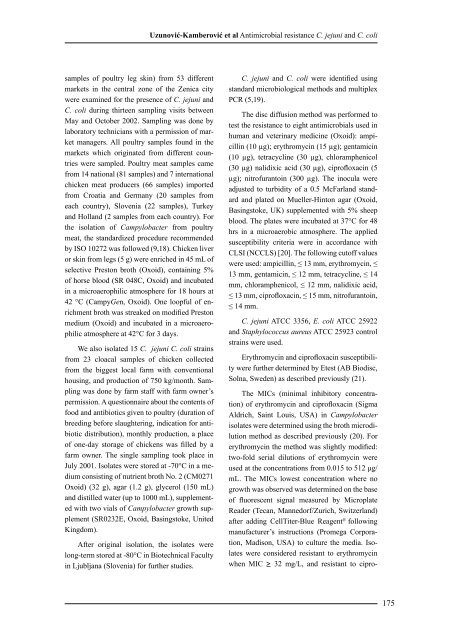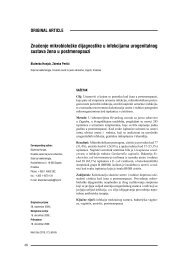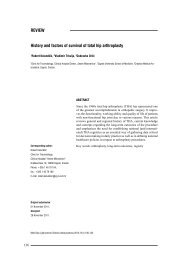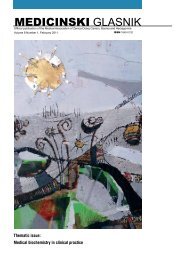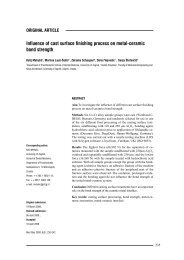MEDICINSKI GLASNIK
MEDICINSKI GLASNIK
MEDICINSKI GLASNIK
Create successful ePaper yourself
Turn your PDF publications into a flip-book with our unique Google optimized e-Paper software.
samples of poultry leg skin) from 53 different<br />
markets in the central zone of the Zenica city<br />
were examined for the presence of C. jejuni and<br />
C. coli during thirteen sampling visits between<br />
May and October 2002. Sampling was done by<br />
laboratory technicians with a permission of market<br />
managers. All poultry samples found in the<br />
markets which originated from different countries<br />
were sampled. Poultry meat samples came<br />
from 14 national (81 samples) and 7 international<br />
chicken meat producers (66 samples) imported<br />
from Croatia and Germany (20 samples from<br />
each country), Slovenia (22 samples), Turkey<br />
and Holland (2 samples from each country). For<br />
the isolation of Campylobacter from poultry<br />
meat, the standardized procedure recommended<br />
by ISO 10272 was followed (9,18). Chicken liver<br />
or skin from legs (5 g) were enriched in 45 mL of<br />
selective Preston broth (Oxoid), containing 5%<br />
of horse blood (SR 048C, Oxoid) and incubated<br />
in a microaerophilic atmosphere for 18 hours at<br />
42 °C (CampyGen, Oxoid). One loopful of enrichment<br />
broth was streaked on modified Preston<br />
medium (Oxoid) and incubated in a microaerophilic<br />
atmosphere at 42°C for 3 days.<br />
We also isolated 15 C. jejuni C. coli strains<br />
from 23 cloacal samples of chicken collected<br />
from the biggest local farm with conventional<br />
housing, and production of 750 kg/month. Sampling<br />
was done by farm staff with farm owner’s<br />
permission. A questionnaire about the contents of<br />
food and antibiotics given to poultry (duration of<br />
breeding before slaughtering, indication for antibiotic<br />
distribution), monthly production, a place<br />
of one-day storage of chickens was filled by a<br />
farm owner. The single sampling took place in<br />
July 2001. Isolates were stored at -70°C in a medium<br />
consisting of nutrient broth No. 2 (CM0271<br />
Oxoid) (32 g), agar (1.2 g), glycerol (150 mL)<br />
and distilled water (up to 1000 mL), supplemented<br />
with two vials of Campylobacter growth supplement<br />
(SR0232E, Oxoid, Basingstoke, United<br />
Kingdom).<br />
After original isolation, the isolates were<br />
long-term stored at -80°C in Biotechnical Faculty<br />
in Ljubljana (Slovenia) for further studies.<br />
Uzunović-Kamberović et al Antimicrobial resistance C. jejuni and C. coli<br />
C. jejuni and C. coli were identified using<br />
standard microbiological methods and multiplex<br />
PCR (5,19).<br />
The disc diffusion method was performed to<br />
test the resistance to eight antimicrobials used in<br />
human and veterinary medicine (Oxoid): ampicillin<br />
(10 µg); erythromycin (15 µg); gentamicin<br />
(10 µg), tetracycline (30 µg), chloramphenicol<br />
(30 µg) nalidixic acid (30 µg), ciprofloxacin (5<br />
µg); nitrofurantoin (300 µg). The inocula were<br />
adjusted to turbidity of a 0.5 McFarland standard<br />
and plated on Mueller-Hinton agar (Oxoid,<br />
Basingstoke, UK) supplemented with 5% sheep<br />
blood. The plates were incubated at 37°C for 48<br />
hrs in a microaerobic atmosphere. The applied<br />
susceptibility criteria were in accordance with<br />
CLSI (NCCLS) [20]. The following cutoff values<br />
were used: ampicillin, ≤ 13 mm, erythromycin, ≤<br />
13 mm, gentamicin, ≤ 12 mm, tetracycline, ≤ 14<br />
mm, chloramphenicol, ≤ 12 mm, nalidixic acid,<br />
≤ 13 mm, ciprofloxacin, ≤ 15 mm, nitrofurantoin,<br />
≤ 14 mm.<br />
C. jejuni ATCC 3356, E. coli ATCC 25922<br />
and Staphylococcus aureus ATCC 25923 control<br />
strains were used.<br />
Erythromycin and ciprofloxacin susceptibility<br />
were further determined by Etest (AB Biodisc,<br />
Solna, Sweden) as described previously (21).<br />
The MICs (minimal inhibitory concentration)<br />
of erythromycin and ciprofloxacin (Sigma<br />
Aldrich, Saint Louis, USA) in Campylobacter<br />
isolates were determined using the broth microdilution<br />
method as described previously (20). For<br />
erythromycin the method was slightly modified:<br />
two-fold serial dilutions of erythromycin were<br />
used at the concentrations from 0.015 to 512 μg/<br />
mL. The MICs lowest concentration where no<br />
growth was observed was determined on the base<br />
of fluorescent signal measured by Microplate<br />
Reader (Tecan, Mannedorf/Zurich, Switzerland)<br />
after adding CellTiter-Blue Reagent ® following<br />
manufacturer’s instructions (Promega Corporation,<br />
Madison, USA) to culture the media. Isolates<br />
were considered resistant to erythromycin<br />
when MIC ≥ 32 mg/L, and resistant to cipro-<br />
175


